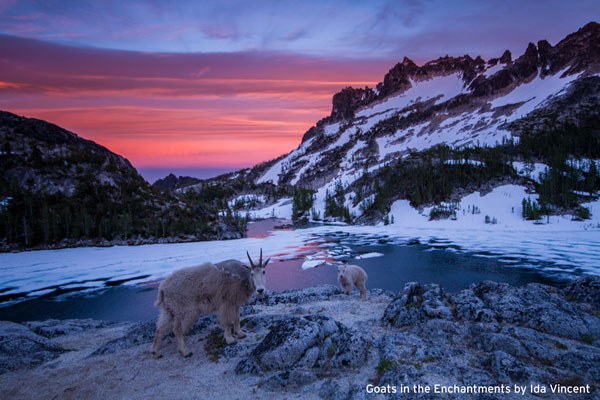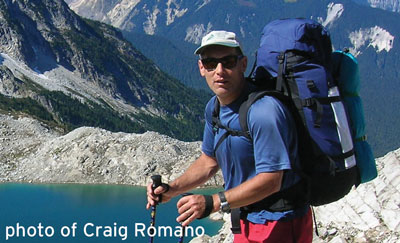
by Craig Romano, Guidebook author
Imagine that you’ve just hiked all day over steep and challenging terrain to a beautiful little alpine lake far from the weekend crowds. It’s hot. You’re alone. Off come the clothes. You make a splash and then you hear the whining buzz of an unmanned aircraft — a drone.
And it’s hovering right above you! What the heck? How about some privacy?
Or picture this. You’ve set up your blind at the edge of a wilderness meadow. Your tripod is set and a herd of mountain goats complete with nursing kids have just taken up residence right before you. Focus set — zoom in — what the… ? A buzzing drone comes out of nowhere. It flies over and near the goats and they are agitated. They flee. They’re stressed. And you can forget about your picture. Some inconsiderate hobby drone operator however has probably already posted his on the net — with little regards that he harassed his subjects to get it.
If you haven’t experienced a drone impacting your backcountry experience yet, you soon will as the amount of hobbyist drone owners is growing exponentially. Like all new technology, drones create opportunities and problems. They have positive uses and abuses. And their proliferation is creating new scenarios that we as a society have not yet addressed. Issues like privacy and wilderness ethics violations. Issues whose full impacts and implications have yet to be understood and addressed by our government officials. Issues that most certainly warrant a set of sound and reasonable rules and regulations to address them. And issues that reticent government officials must address now — before drone usage is entrenched in places it probably shouldn’t be — and to thwart potential conflicts and legal action down the road.
Unless you’re a Luddite or completely intolerant, you probably can agree that private citizens should be able to own and operate drones at some capacity. And unless you’re a strict libertarian, you probably can agree that drones need to be regulated. As of October 2015 the Federal Aviation Administration, and the US Department of Transportation have finally realized this and are working on a fast track (by the time you read this) to enact regulations that includes among other things registration. According to an October 18th article in the Wall Street Journal,
The department plans to create a task force of more than two dozen government and industry representatives to recommend the specifics of a registration policy, including which drones should be included, how users will register and whether the rules will apply to drones already sold, according to people familiar with the plans. The draft news release says the department wants to “create a culture of accountability” for drone operators.
I imagine many drone owners (like gun owners) may object to registering — but this is one way of tracking down drone owners who violate the few (but sure to grow) laws that are in place regulating their use. Laws are currently on the books restricting drones from being flown over military bases, commercial airports, and national park lands. But as they are currently written, it is near impossible to enforce these regulations. However, according to the WSJ article, “Registration would be one of regulators’ most ambitious steps to crack down on unsafe flights and enforce existing rules, including that drones can’t be flown near airports or beyond the sight of an operator.”
So before angry drone owners start declaring these rules and regulations as unfair and a violation of their rights, let’s look at your and my rights to recreate on our public lands without being spied on and hassled. Do you have a right to fly your drone over public lands? For now you can legally fly drones in national forest lands except wilderness areas, wildlife refuges and most state parks. Wilderness areas clearly prohibit them as they fall under the motorized equipment statues. In 2014 the National Park Service temporarily banned them while the agency studies the situation more fully to come up with a solid set of regulations pertaining to their use. Does that mean they will be permanently banned from places like Mount Rainier, Mount Rushmore and the Everglades? Perhaps. Perhaps not. But irresponsible drone operators — and there is a long list of them from drones being flown into Yellowstone’s Old Faithful to drones harassing tourists and wildlife — certainly won’t be doing any favors for responsible drone operators.
So what is a responsible drone operator? I imagine it’s someone who operates his aircraft safely and with sensitivities toward the people, wildlife and cultural artifacts around him. And how do we define that? While I have no objection to someone wanting to photograph something from the air with their drone, what I do object to is my privacy being violated. I expect that when I am squatting behind a tree, sunbathing in the buff or getting frisky with my wife while out in the backcountry that I’m not being filmed! And I expect some serenity too. The last thing I want to hear when listening to serenading loons on a quiet evening is the whines of machinery. I head to the backcounty to escape the commotion, clutter and noise of the 21st century.
Before anyone labels me a Luddite; au contraire. I embrace technology when it has practical and sensible applications. Technology has made both my professional and personal life a lot better and more convenient than in the past. But I also exercise restraint (as I do with food, alcohol, etc.) so that I may live a balanced life. And when I take to the woods, I want a simpler quieter more serene existence.
Yes, I understand and recognize all of the great and beneficial things that can be done with drones. They can help locate someone for a rescue. They can aid wildlife managers, foresters, law enforcement, utility companies, fire fighters, border patrol, military operations, land managers, etc. And of course their uses for photographing and film making allow for making and viewing imagery that could not be created before. Yes, I have enjoyed some pretty spectacular videos and stills shot with a drone.
So how do we balance the wants of drone operators with the wants of folks that don’t want to be bothered by their machines? First we hikers, outdoor recreationists and conservationists have to do some real soul searching on whether these machines even belong in the backcountry. Can you envision not too far into the future a Saturday afternoon at your favorite summit with a score of drones buzzing around? And aside from the noise and privacy concerns, drones carry danger risks too. Many a machine has crashed. As I write this some errant drone operator crashed his machine into the Seattle waterfront Ferris wheel — a no fly zone! They are a hazard around airplanes and fire fighters. And I imagine if I was dangling on the face of El Capitan I wouldn’t want one buzzing near me either. They can be a nuisance to wildlife too — disturbing and harassing them by their very presence and sounds.
If you’re looking to go “Wild” next year on the PCT, take note. I have caught wind of a duo planning on doing the 2650-mile trek while being followed by drones (despite all the wilderness areas and national parks the trail goes through) the entire distance. Would you like to be hiking with or near them with this constant intrusion? Perhaps you may want to “Take a walk in the woods,” instead as drones are banned (for now) from the AT as this 2180-mile trail is administered by the National Park Service. Clearly, any rules and regulations that we consider addressing drone use in the backcountry needs to be consistent.
So what do you think? Should drones be allowed in our wild places? And if so, where and how will their presence impact the way you recreate in our precious backcountry?
 Craig Romano is an avid hiker, runner, paddler, and cyclist, and has written about these passions for over two dozen publications, including Seattle Met, Backpacker, Northwest Runner, AMC Outdoors, Northwest Travel, and Outdoors NW. He is the content provider for Hikeoftheweek.com, author of ten books and co-author of four others including the recently released Day Hiking the San Juans and Gulf Islands and Day Hiking Mount St Helens.
Craig Romano is an avid hiker, runner, paddler, and cyclist, and has written about these passions for over two dozen publications, including Seattle Met, Backpacker, Northwest Runner, AMC Outdoors, Northwest Travel, and Outdoors NW. He is the content provider for Hikeoftheweek.com, author of ten books and co-author of four others including the recently released Day Hiking the San Juans and Gulf Islands and Day Hiking Mount St Helens.
This article originally appeared in our Winter 2016 issue of Mountaineer magazine. To view the original article in magazine form and read more stories from our publication, click here.
 Craig Romano
Craig Romano